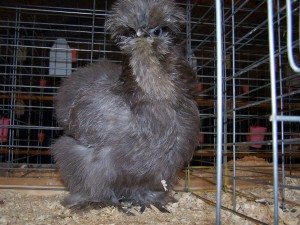MacopinFarm.com
Araucanas, eggs for hatching, fine wool and fiber.
- About
- Araucanas
- Call for Prayer 24/7
- For Sale
- Photos/Videos/Details
- Bearded Silkies (Bantams)
- Camp pictures 2012 Trip 2
- Camp pictures 2012 Trip 3
- Chick pictures!
- CHICKS FROM PETE’S GROUP, (July 2012) ETC
- DUTCH are one of the few “True” Bantams. We raise Lemon Blue & Black Dutch.
- Past show results
- Peafowl Pictures
- Polish/Silver Phoenix cross hen
- Sheep
- Silver Spangled Hamburgs
- What’s New in June 2012?
- You tube Videos
- Posts/Blogs
- Resumes
Blogging by WordPress - Theme Created by egyptian wordpress themes in partnership with airport parking

hi, what a beauty!!
Yes she sure is! Thanks for the compliment, I will tell Lobelia :-).
Wow… never saw a chicken that color…or that beautiful… Where are they from originally… or is that a dumb question?
The following taken from the American Silkie Bantam Club for more info follow the link below.
The Beautiful Silkie Bantams
Silkie Bantams are some of the most charming and beguiling oddities of the Poultry Fancy. They possess many characteristics that set them apart from the other breeds of chickens; the most obvious being the texture of their feathers which is almost fur or silk-like in appearance – hence their name. Feathers have several parts to them; the main part being the quill that grows from beneath the skin which tapers off up the center of the feather to become the shaft. From each side of the shaft comes the web which are tiny strands that are held together by small hooks or barbicels on the ends of the strands which gives the feather their typical appearance. The Silkie does not have the hooks on the ends of the tiny strands of the web, which are fluffed out rather than held together.
They also possess topknots or crests on their heads and abundant feathers growing down their legs and middle toe. They compete in the Featherleg Bantam class at poultry shows. Silkies are among the few other breeds of chickens that possess five toes instead of the usual four. They are the only chicken to have black, or more exactly, dark slate-blue skins. Silkies also come in a Bearded and Non-bearded variety, and can be found in many different colors. The colors which are recognized by both the American Poultry Association and the American Bantam Association are White, Black, Blue, Buff, Gray, Partridge and Splash.
The exact date and place of origin of the Silkies is not known, however Marco Polo wrote of the fur-covered fowl with black skin during his journeys to China in the 13th century. It is safe to assume that Silkies had been around quite a while before Marco Polo. The Silkie of that time and the modern Silkie do not resemble each other in many other respects, being that the ancient Silkies evidently did not have leg feathering or any crest to speak of. As a matter of fact, the Silkie seen in the showroom today has changed considerably in the last 30 to 40 years. Their crests are larger and the feathering down the legs is more abundant than seen previously. Also a larger variety of colors are found today. The original Silkies were white only, but through meticulous and vigilant breeding by some dedicated fanciers the colors are becoming much better in quality than they were.
Because of their gentle and docile nature, they make wonderful pets and adapt quickly to attention and handling by people.
http://www.americansilkiebantamclub.org/silkies.asp